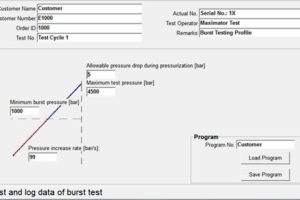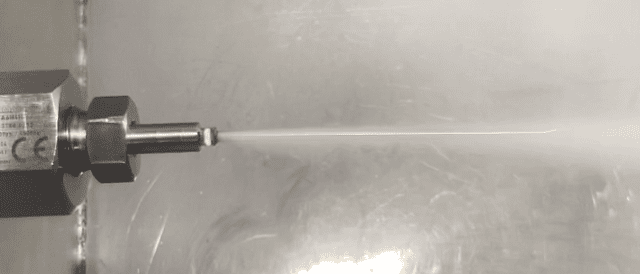Burst Pressure Testing – Up To 145,000 PSI
Maximator Test conducts hydrostatic Burst Pressure Testing at pressures up to 65,000 psi using water. We can also Burst test to 145,000 psi using hydraulic fluid and up to 11,250 psi using inert gas such as Nitrogen or Helium. Testing is conducted using a plc-controlled and computer regulated test bench, or a manually operated gas booster assembly equipped with NIST traceable pressure gages. The test bench features data acquisition in PDF or CSV format, ISO/IEC 17025 calibrated primary and secondary pressure transducers, and protective safety features. With up to 10-programmable pressure intervals, Maximator Test can assist you with all your Burst Pressure Testing needs.
Burst Pressure Testing Equipment
Programmable pressure ramp rate and maximum pressure drop offers flexibility to meet your Burst Pressure Testing needs.
Burst Pressure Testing is a type of destructive test used to determine the absolute maximum pressure a component will burst, fail catastrophically, or begin to plastically deform when pressurized under controlled conditions. Burst Pressure Testing can be help design engineers determine material of construction, wall thickness and component geometry.
Benefits of Burst Testing:
- Identify maximum burst pressure
- Confirm design margin
- Determine failure mode
- Find the weakest link in a component or assembly
The failure mode of this pressure vessel, at 2,000 psi, caused a sudden release of pressure where a rupture in the tube wall was present. Schedule your Burst Pressure Testing with Maximator Test today to find the stress risers in your production samples.
Knowing the maximum burst pressure is a vital consideration for any component under pressure. It can help establish safety design margins and even be the key to using a component in a new application. If failure is not an option, then you must identify the maximum burst pressure.
Determining the failure mode is critical for pressurized component, especially if they are used in applications that are out in the open and exposed to employees. Knowing how a component will burst or leak is very important. Will a component crack and lose pressure or will it fail catastrophically, sending shrapnel in all directions?
The failure mode of this component, at 50,000 psi, caused a catastrophic failure in which a waterjet-like projectile was made. Perform Burst Pressure Testing with Maximator Test today to understand the common failure modes of your components.
Burst Pressure Testing will identify the weak link in a component or assembly which provides valuable information on the design. Design improvements are not always used to remedy physical weaknesses or flows. Sometimes, a component can be over-engineered, impacting the economy of the item and it may benefit the manufacturer by choosing a different material of construction or features to reduce the per piece cost.
Regardless of what phase of production a component is in, Burst Pressure Testing is a common, cost-effective way to obtain the necessary data to improve the economy of the part. Preproduction burst testing might be required to meet quality and safety standards. Sometimes ongoing lot testing is required after a component goes into production.
The failure mode of this ultra-high-pressure vessel, at 130,000 psi, caused a catastrophic failure where the body fractured under the pressure load. With Maximator Test, all your extreme Burst Pressure Testing problems will be solved.
Burst Pressure Testing can also be combined with Proof Pressure Testing. The test parameters in a combined Burst/Proof Pressure Test may require a part to be pressurized and then dwell or hold a specific pressure for a desired time interval and then continue to be pressurized until the component fails, all in a single test. The equipment used at Maximator Test allows a component to be pressurized and dwell up to nine pressure intervals before being pressurized until it bursts.
This pressure vessel was Proof Pressure tested to 1,100 psi minimum for 60 seconds minimum before increasing the pressure at a defined ramp rate until the Burst Pressure was reached at 4,349 psi.
Maximator Test® will provide a comprehensive test report. The report will include:
- An outline of the testing objectives
- The tools and equipment used to conduct the test
- The test set-up and procedure, including photographs of how the setup was completed. In most cases, video recording of the test is also possible.
- Results, including pressure plots, data tables, comments and observations made while conducting the test
- Failure photos showing failure locations
- Calibration certificates








